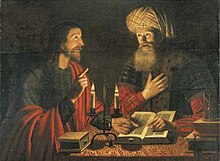O heilges Geist- und Wasserbad, BWV 165

O heilges Geist- und Wasserbad ("O bath of Holy Spirit and of water", literally: "O holy bath of Spirit and water "), BWV 165, is a church cantata by Johann Sebastian Bach. He composed it in Weimar for Trinity Sunday and likely first performed it on 16 June 1715.
History and words

In Weimar, Bach was the court organist of Johann Ernst von Sachsen-Weimar. On 2 March 1714, he was promoted to Konzertmeister, an honour which included a monthly performance of a church cantata in the Schlosskirche. He composed the cantata for Trinity Sunday.[1] The prescribed readings for the Sunday were from the Epistle to the Romans, reflecting "depth of wisdom" (Romans 11:33–36), and from the Gospel of John, the meeting of Jesus and Nicodemus (John 3:1–15).
The cantata text was written by court poet Salomon Franck and published in Evangelisches Andachts-Opffer in 1715. The poet follows the Gospel closely and reflects in a recitative as movement 2 that the second birth in the Spirit which Jesus mentions, is the baptism as an act of mercy. Movement 3, an aria, considers that the bond has to be renewed throughout life, because it will be broken by man (movement 4). The last aria is a prayer for the insight that the death of Jesus brought salvation. The cantata is concluded by the fifth stanza of Ludwig Heimbold's Nun lasst uns Gott dem Herren, mentioning scripture, baptism and Eucharist.[2]
Bach likely first performed the cantata on 16 June 1715 and performed it again in his first year in Leipzig, probably to conclude it on Trinity Sunday, 4 June 1724, with minor changes.[1]
Scoring and structure
The cantata is scored for four soloists, soprano, alto, tenor and bass, a four-part choir, bassoon, two violins, viola, and basso continuo.[1]
- Aria (soprano): O heilges Geist- und Wasserbad
- Recitative (bass): Die sündige Geburt verdammter Adamserben
- Aria (alto): Jesu, der aus großer Liebe
- Recitative (bass): Ich habe ja, mein Seelenbräutigam
- Aria (tenor): Jesu, meines Todes Tod
- Chorale: Sein Wort, sein Tauf, sein Nachtmahl
References
- ^ a b c Dürr, Alfred (1971). Die Kantaten von Johann Sebastian Bach (in German). Vol. 1. Bärenreiter-Verlag. OCLC 523584.
- ^ "Nun lasst uns Gott dem Herren / Text and Translation of Chorale". bach-cantatas.com. 2005. Retrieved 30 May 2012.
Sources
The first source is the score.
General sources are found for the Bach cantatas. Several databases provide additional information on each single cantata:
- Cantata BWV 165 O heilges Geist- und Wasserbad history, scoring, sources for text and music, translations to various languages, discography, discussion, bach-cantatas website
- BWV 165 – "O heilges Geist- und Wasserbad" English translation, discussion, Emmanuel Music
- O heilges Geist- und Wasserbad history, scoring, Bach website Template:De icon
- BWV 165 O heilges Geist- und Wasserbad English translation, University of Vermont
- BWV 165 O heilges Geist- und Wasserbad text, scoring, University of Alberta
